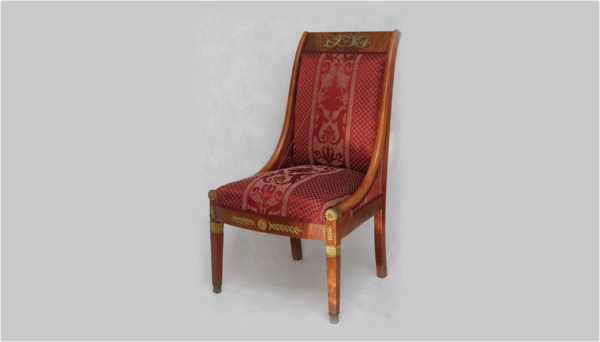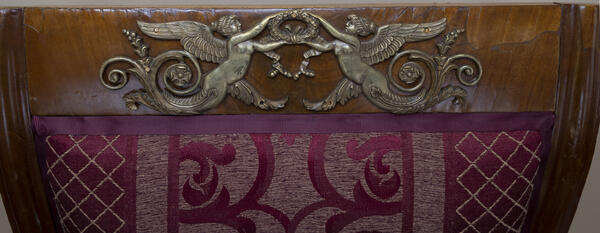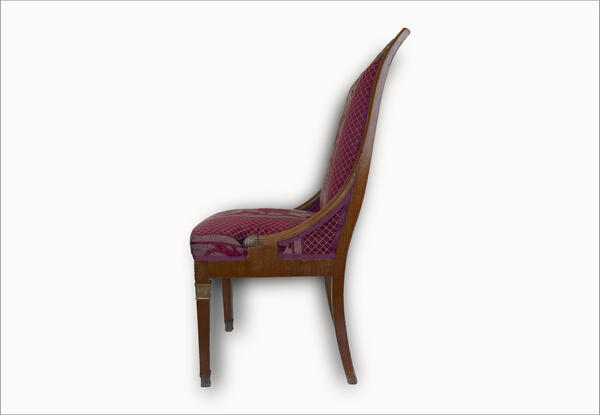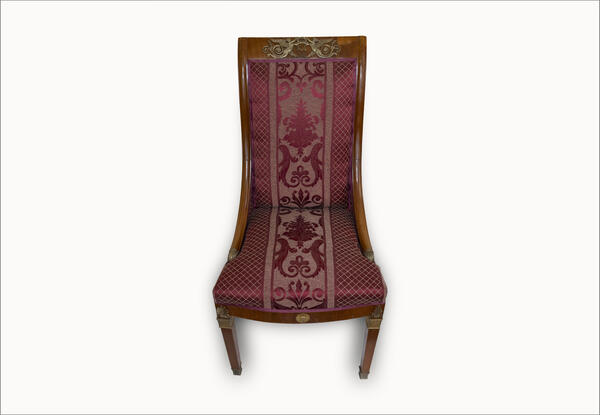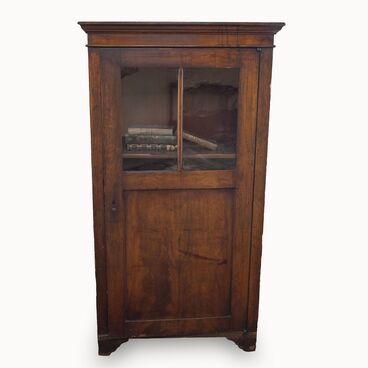The collection of the Decembrists House Museum includes an armchair and chair made in the Empire style that are part of one set. In the first third of the 19th century, furniture was often created in sets so that all elements were of a common design.
The armchair’s rectangular back is padded with a soft material on one side, while the other one is covered with fabric only. The satin upholstery has a Slavic floral print.
The Empire style originated in and took its name from the rule of Emperor Napoleon I in the First French Empire and was intended to idealize the power of the state. The brochure with furniture and interior designs, published in 1801 by Pierre Fontaine and Charles Percier, contributed to the widespread use of the Empire style. This trend was based on the traditions of classicism and also gravitated toward the strict forms of ancient Roman and Egyptian art. Oftentimes furniture was decorated with ancient motifs borrowed from monuments or images on vases.
From 1800 to 1830, the interiors of imperial palaces, mansions of the aristocracy, and noble houses were characterized by the Russian Empire style, which speaks to the great influence of French art. The extensive development of the Empire style in furniture was taking place against the backdrop of major historical events: the victory over Napoleon I in the Patriotic War of 1812, and the restoration of Moscow after the fire.
During the reign of Alexander I, furniture was created by the Gambs, Tur, and Bauman furniture firms in Saint Petersburg, as well as by the Pick furniture manufacturer in Moscow. Good furniture also came from workshops of the palaces of Ostankino and Arkhangelskoye, and freelance craftsmen from Moscow, Saint Petersburg, Tver, and Kursk.
The book “Saint Petersburg in the Times of Pushkin” has a description of the interior of the living room during that time,
The armchair’s rectangular back is padded with a soft material on one side, while the other one is covered with fabric only. The satin upholstery has a Slavic floral print.
The Empire style originated in and took its name from the rule of Emperor Napoleon I in the First French Empire and was intended to idealize the power of the state. The brochure with furniture and interior designs, published in 1801 by Pierre Fontaine and Charles Percier, contributed to the widespread use of the Empire style. This trend was based on the traditions of classicism and also gravitated toward the strict forms of ancient Roman and Egyptian art. Oftentimes furniture was decorated with ancient motifs borrowed from monuments or images on vases.
From 1800 to 1830, the interiors of imperial palaces, mansions of the aristocracy, and noble houses were characterized by the Russian Empire style, which speaks to the great influence of French art. The extensive development of the Empire style in furniture was taking place against the backdrop of major historical events: the victory over Napoleon I in the Patriotic War of 1812, and the restoration of Moscow after the fire.
During the reign of Alexander I, furniture was created by the Gambs, Tur, and Bauman furniture firms in Saint Petersburg, as well as by the Pick furniture manufacturer in Moscow. Good furniture also came from workshops of the palaces of Ostankino and Arkhangelskoye, and freelance craftsmen from Moscow, Saint Petersburg, Tver, and Kursk.
The book “Saint Petersburg in the Times of Pushkin” has a description of the interior of the living room during that time,

